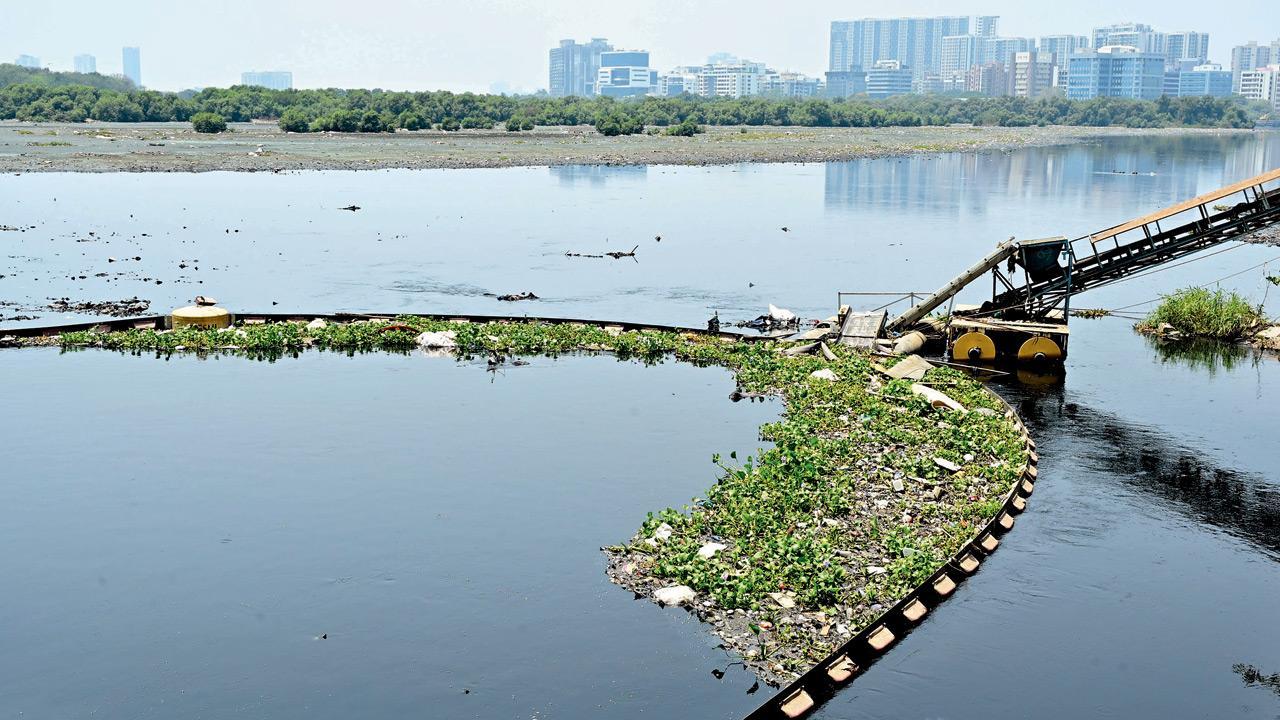Environmentalists slam civic body for years-long delay despite visible nullah pollution and NGT mandate in 2022; civic officials explained that trash booms are floating nets that help stop plastic, thermocol, and other debris from flowing into creeks or the sea

A trash boom with a conveyor system in Mithi River under the BKC connector. Pic/Shadab Khan
The Brihanmumbai Municipal Corporation (BMC) has decided to install trash booms in six more nullahs in the western suburbs, three years after the National Green Tribunal (NGT) issued an order for the same. Civic officials explained that trash booms are floating nets that help stop plastic, thermocol, and other debris from flowing into creeks or the sea.
ADVERTISEMENT
Environmentalists who had petitioned against the BMC said the delay in implementing the NGT’s order has led to continued pollution in mangrove forests and along beaches. In 2022, the NGT directed the BMC to prevent floating waste from reaching the sea and mangrove areas. Acting on the directive, the BMC installed trash booms at nine locations that year.
Subsequently, tenders were floated for a wider project, estimated to cost Rs 35 crore. This project covers the installation and commissioning of trash booms and the removal and disposal of floating waste and includes five years of operation and maintenance in various nullahs of the western suburbs.
According to the BMC, the new trash booms will be placed at Rajendra Nagar nullah in Gorai; Ramchandra nullah and Mahakali nullah in Malad—both of which connect to the Malad creek; Shastri nullah and Primal nullah in Goregaon; and Krishna Nagar nullah in Andheri East —all of which feed into the Mithi River. A civic official noted that the exact locations might change depending on high and low tide conditions.
Civic officials justified the delay in expanding the project, saying they were monitoring the results of previously installed booms. “We are now convinced that the trash booms are useful,” an official said.
During a recent visit to the Mankhurd-Govandi nullah desilting site, Additional Municipal Commissioner Abhijit Bangar observed floating waste in the water. He proposed installing tall mesh barriers and sealing off narrow lanes leading to the drains with either mesh screens or Fiber-Reinforced Polymer (FRP) meshes at key spots.
‘20-24 spots for trash booms’
“There are about 20 to 24 locations where trash booms need to be set up. However, this system requires space around the nullah for the conveyor belts that help lift the trash off the trash booms. So, we’re also looking at the option of placing mesh barriers to stop people from dumping floating waste into the drains,” a civic official said.
Environmental activist Stalin D, who filed the NGT petition demanding measures to prevent floating waste from polluting creeks and mangroves, criticised the delay. “By now, these booms should have been put in all nullahs. We don’t understand why BMC is delaying implementation. Who is responsible for the delay that pollutes natural water bodies? This floating material is also harmful to marine life,” he said.
Currently, trash booms are operational at eight locations: Gazdhar Bund and Main Avenue nullah in Juhu, Mogra nullah in Andheri, Oshiwara River, Poisar River, Dahisar River, Vakola River, and the Mithi River.
A BMC official said, “In 2019, BMC installed trash booms in a few nullahs, including the Mithi River. But that experiment failed as there was no mechanism to collect trapped waste. However, the new system installed in 2022 includes a pontoon-mounted conveyor system that collects waste trapped in the boom, which is very useful.”
 Subscribe today by clicking the link and stay updated with the latest news!" Click here!
Subscribe today by clicking the link and stay updated with the latest news!" Click here!







